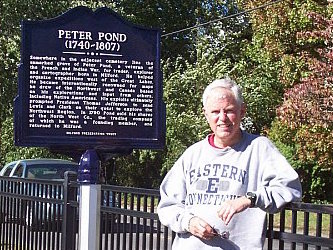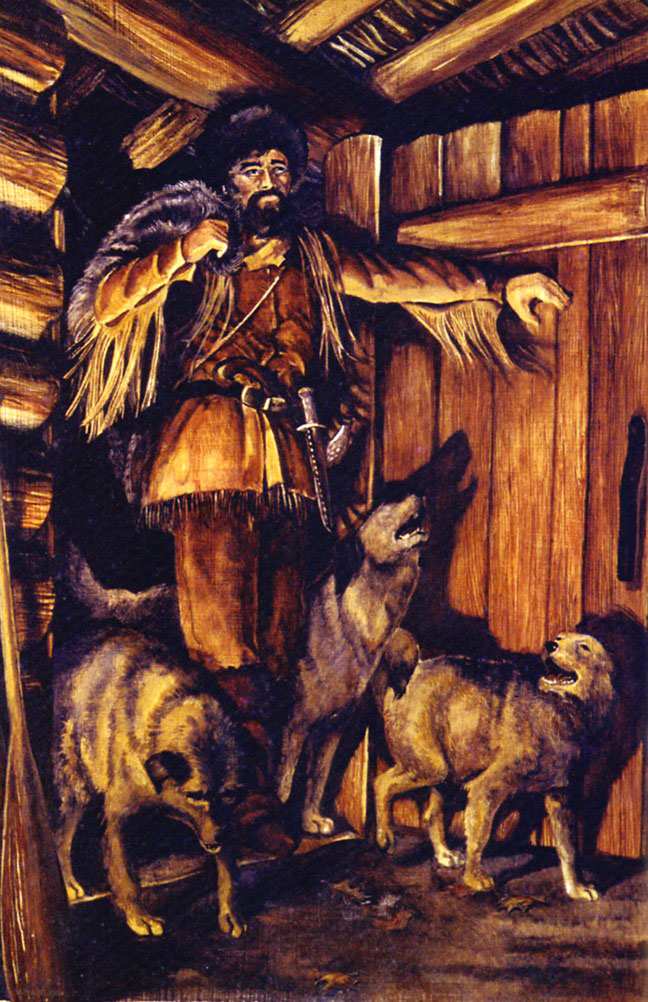Peter Pond newsletter :: November 2002 :: #14
holiday newsletter
Happy Holidays to all. Let this be my holiday newsletter unless something else comes up before the end of the year.
PETER POND GRAVESITE
I feel I owe an explanation after alluding to something big on the horizon for the past six months. In fact, I have been expecting all this time a written proposal from Connecticut State Archeologist Nicholas Bellantoni on his interest to examine the area around that gravesite in Milford Cemetery that was the focus of a professional radar scan in October 2001. You may remember that the scan taken next to the headstone of Peter Pond's mother, Mary, showed her grave plus two next to her that were unmarked. He is interested in seeing who is in those two unmarked graves.
I wrote to Bellantoni, he visited the site in February 2002 with his associate, David Poirier, staff archeologist and environmental review coordinator with the Connecticut Historical Commission. They looked around, looked at the radar scan report, checked my website, and expressed interest in doing an archeological dig. First they said they'd come in August, then in October, each time putting me off due to other similar projects. Now the goal is for spring/summer 2003. Nick notes the possibility of using state-of-the art DNA analysis which has not yet been part of his budget.
A television show on using DNA to identify those in unmarked graves is set for PBS in the USA 8 p.m. Nov. 20. It's called "Titanic's Ghosts" and deals with how modern DNA testing was used to identify unknown Titanic dead buried in Halifax, Nova Scotia.
You can find out more about Nick Bellantoni and his work.
On DNA, Nick said in an 11/14 email: "In the past, we have not used DNA analysis due to its expense - when you do not have a budget!! Anyhow, the Henry Lee Institute for Forensic Science is in the process of purchasing the lab equipment for DNA and has offered to assist us in identification projects we encounter. So, by next year, we may have an opportunity to test Peter Pond. We would need a portion of bone or tooth (if it has survived), and a sample (hair with roots) from a descendent - primarily a descendent from Peter's mother's family."
Peter Pond descendants, take note.
Nick also requires permission from a family member to work at the site, which I have obtained. The cemetery commission is reserving comment until they see the proposal. One concern I have is if they are both Pond siblings in those 2 unmarked graves, what then? Mary had eight children, Peter Pond being the oldest. Nick did say that bones could still exist, and Peter Pond was supposed to be a big man. Hopefully some Indian artifact unique to Western Canada might be buried with him. We'll see when and if the time comes.
If all this comes to fruition, a proper reburial would ensue. From there I would see to it that a proper grave marker is installed. I believe it could be done for free since the federal government would cover the cost of a marker for a war veteran, inasmuch as Peter Pond served in a Connecticut regiment during the French and Indian War.
TRACING ROOTS
A new and valued contact as the result of this website is Claire Dickens, of Albuquerque, New Mexico. She claims to be a half-breed (metis) descendent of Peter Pond through Augustus Peter Pond, born at Athabasca around 1790. She showed me her card claiming membership in the Chipewah tribe. I believe Augustus is the same one identified in Duckworth's "English River Book" who was a blacksmith and later settled in Sorel, Quebec. Claire called me in early September, passing through Milford on a two-month quest to seek her roots which would take her to her native Orwell, VT and into Canada. I gave her the Milford tour of Peter Pond sites and she treated me to dinner, as some of you other visiting Peter Pond Society members so graciously have. She didn't make it to Sorel but plans to spend the whole winter on geneology. She is also willing to take a DNA test to establish her connection to Peter Pond.
The Survival of the Bark Canoe
Finally, a small note from Judy Pond of Vermont led me onto a rather interesting weekend quest this fall. You'll remember Judy is the middle school teacher who obtained a grant to visit Peter Pond country in Saskatchewan and Alberta to study the fur trade and establish her roots, plus paddle the Clearwater River. So she took a canoe trip in Maine last summer and the guide said he had heard of Peter Pond, through reading of the John McPhee book, "The Survival of the Bark Canoe," (Farrar, Straus and Giroux, New York, 1975). That is a small but lyrical book on Henri Vaillancourt of New Hampshire as one of the last to preserve the native art of making birch bark canoes. I had read the book about 15 years ago but did not remember the Peter Pond reference. Judy said it was on page 57, the only name mentioned in a discussion of the Canadian fur trade period and how birch bark canoes were a valuable part.
So I re-read the book and enjoyed it again. I even took Vaillancourt's Bible out of the library, "The Bark Canoes and Skin Boats of North America" by Adney and Chapelle and read the chapter on fur trade canoes. Then on pages 62-63 of the McPhee book was the part about the only actual fur trade canoe Vaillancourt ever made, a 25-foot North canoe for a graduate school program out of Shokan, N.Y. The director, Kent Reeves, ordered the canoe and used it for years in Canadian trips using authentic clothing and equipment ie paddles students made themselves. This was part of the State University of New York at New Paltz' Ashokan Field Campus for which I soon found the website.
To make a long story short, I found the Ashokan Field Campus deep in the Catskills on the way back from my sister's house in Canaan, N.Y. in the Berkshires in early October. Reeves had passed away but his successor and participant on many Canadian trips, Andy Angstrom, let me see the canoe, now tucked away in a large barn and hanging on wooden racks. I could reach up and touch it, pat it, and was fascinated to see how it felt and sounded like a thick wad of paper, every component - thwarts, floor slats and root wrappings inserted by hand - the first time I had seen and touched a bark canoe. This was the way Peter Pond got around. Thanks, Judy, for mentioning the McPhee book that set me on another Peter Pond Pilgrimage. I can send photos of the canoe on request and will eventually put some on the website.

Once again, Happy Holidays and best of the New Year.
Au revoir,
Bill
website design by Daniel Ortoleva
